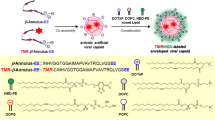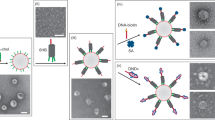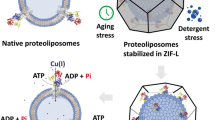Abstract
Anionic polyelectrolytes and cationic lipid membranes can self-assemble into lamellar structures ranging from alternating layers of membranes and polyelectrolytes1,2,3,4,5,6,7,8,9,10,11 to 'missing layer' superlattice structures12. We show that these structural differences can be understood in terms of the surface-charge-density mismatch between the polyelectrolyte and membrane components by examining complexes between cationic membranes and highly charged M13 viruses, a system that allowed us to vary the polyelectrolyte diameter independently of the charge density. Such virus–membrane complexes have pore sizes that are about ten times larger in area than DNA–membrane complexes, and can be used to package and organize large functional molecules; correlated arrays of Ru(bpy)32+ macroionic dyes have been directly observed within the virus–membrane complexes using an electron-density reconstruction. These observations elucidate fundamental design rules for rational control of self-assembled polyelectrolyte–membrane structures, which have applications ranging from non-viral gene therapy13,14,15,16 to biomolecular templates for nanofabrication17.
This is a preview of subscription content, access via your institution
Access options
Subscribe to this journal
Receive 12 print issues and online access
$259.00 per year
only $21.58 per issue
Buy this article
- Purchase on Springer Link
- Instant access to full article PDF
Prices may be subject to local taxes which are calculated during checkout




Similar content being viewed by others
References
Radler, J.O., Koltover, I., Salditt, T. & Safinya, C.R. Structure of DNA-cationic liposome complexes: DNA intercalation in multilamellar membranes in distinct interhelical packing regimes. Science 275, 810–814 (1997).
Subramanian, G. et al. Structure of complexes of cationic lipids and poly(glutamic acid) polypeptides: A pinched lamellar phase. J. Am. Chem. Soc. 122, 26–34 (2000).
Ponomarenko, E.A., Waddon, A.J., Bakeev, K.N., Tirrell, D.A. & MacKnight, W.J. Self-assembled complexes of synthetic polypeptides and oppositely charged low molecular weight surfactants solid-state properties. Macromolecules 29, 4340–4345 (1996).
Antonietti, M., Conrad, J. & Thuenemann, A. Polyelectrolyte-surfactant complexes: A new type of solid mesomorphous material. Macromolecules 27, 6007–6011 (1994).
Salditt, T., Koltover, I., Radler, J.O. & Safinya, C.R. Two-dimensional smectic ordering of linear DNA chains in self-assembled DNA-cationic liposome mixtures. Phys. Rev. Lett. 79, 2582–2585 (1997).
Harries, D., May, S., Gelbart, W.M. & Ben-Shaul, A. Structure, stability, and thermodynamics of lamellar DNA-lipid complexes. Biophys. J. 75, 159–173 (1998).
Golubovic, L. & Golubovic, M. Fluctuations of quasi-two-dimensional smectics intercalated between membranes in multilamellar phases of DNA cationic lipid complexes. Phys. Rev. Lett. 80, 4341–4344 (1998).
O'Hern, C.S. & Lubensky, T.C. Sliding columnar phase of DNA lipid complexes. Phys. Rev. Lett. 80, 4345–4348 (1998).
Bruinsma, R. Electrostatics of DNA-cationic lipid complexes: Isoelectric instability. Eur. Phys. J. B 4, 75–88 (1998).
Bruinsma, R. & Mashl, J. Long-range electrostatic interaction in DNA cationic lipid complexes. Europhys. Lett. 41, 165–170 (1998).
May, S. & Ben-Shaul, A. DNA-lipid complexes: stability of honeycomb-like and spaghetti-like structures. Biophys. J. 73, 2427–2440 (1997).
Wong, G.C.L. et al. Hierarchical self-assembly of F-actin and cationic lipid complexes: Stacked three-layer tubule networks. Science 288, 2035–2039 (2000).
Felgner, P.L. Nonviral strategies for gene therapy. Sci. Am. 276, 102–106 (1997).
Friedmann, T. Overcoming the obstacles to gene therapy. Sci. Am. 276, 96–101 (1997).
Lin, A.J. et al. Three-dimensional imaging of lipid gene-carriers: Membrane charge density controls universal transfection behavior in lamellar cationic liposome-DNA complexes. Biophys. J. 84, 3307–3316 (2003).
Koltover, I., Salditt, T., Radler, J.O. & Safinya, C.R. An inverted hexagonal phase of cationic liposome-DNA complexes related to DNA release and delivery. Science 281, 78–81 (1998).
Liang, H., Angelini, T.E., Ho, J., Braun, P.V. & Wong, G.C.L. Molecular imprinting of biomineralized CdS nanostructures: Crystallographic control using self-assembled DNA-membrane templates. J. Am. Chem. Soc. 125, 11786–11787 (2003).
Lasic, D.D., Strey, H., Stuart, M.C.A., Podgornik, R. & Frederik, P.M. The structure of DNA-liposome complexes. J. Am. Chem. Soc. 119, 832–833 (1997).
Day, L.A., Marzee, C.J., Reisberg, S.A. & Casadevall, A. DNA packing in filamentous bacteriophages. Annu. Rev. Biophys. Biophys. Chem. 17, 509–539 (1988).
Day, L.A., Marzee, C.J., Reisberg, S.A. & Casadevall, A. DNA packing in filamentous bacteriophages. Ann. Rev. Biophys. Biophys. Chem. 17, 509–539 (1988).
Koltover, I., Salditt, T. & Safinya, C.R. Phase diagram, stability, and overcharging of lamellar cationic lipid-DNA self-assembled complexes. Biophys. J. 77, 915–924 (1999).
Koltover, I., Wagner, K. & Safinya, C.R. DNA condensation in two dimensions. Proc. Natl Acad. Sci. USA 97, 14046–14051 (2000).
Lodish, H. et al. Molecular Cell Biology (Scientific American Books, New York, 1995).
Koltover, I., Sahu, S. & Davis, N. Genetic engineering of the nanoscale structure in polyelectrolyte-lipid self-assmbled systems. Angew. Chem. Int. Edn (in the press).
Stupp, S.I. & Braun, P.V. Molecular manipulation of microstructures: Biomaterials, ceramics, and semiconductors. Science 277, 1242–1248 (1997).
Kresge, C.T., Leonowicz, M.E., Roth, W.J., Vartuli, J.C. & Beck, J.S. Ordered mesoporous molecular sieves synthesized by a liquid-crystal template mechanism. Nature 359, 710–712 (1992).
Brinker, C.J. Oriented inorganic films. Curr. Opin. Colloid Interface Sci. 3, 166–173 (1998).
Monnier, A. et al. Cooperative formation of inorganic-organic interfaces in the synthesis of silicate mesostructures. Science 261, 1299–1303 (1993).
Mann, S. Biomineralization: Principles and Concepts in Bioinorganic Materials Chemistry (Oxford Univ. Press, New York, 2002).
Hartgerink, J.D., Beniash, E. & Stupp, S.I. Self-assembly and mineralization of peptide-amphiphile nanofibers. Science 294, 1684–1688 (2001).
Acknowledgements
This material is based upon work supported in part by the US Department of Energy, Division of Materials Sciences under Award No. DEFG02-91ER45439, through the Frederick Seitz Materials Research Laboratory, and carried out in part in the Center for Microanalysis of Materials, which is partially supported by the US Department of Energy under grant DEFG02-91-ER45439, and by NSF-DMR-0409769 and the NSF Nanoscience & Engineering Initiative.
Author information
Authors and Affiliations
Corresponding author
Ethics declarations
Competing interests
The authors declare no competing financial interests.
Rights and permissions
About this article
Cite this article
Yang, L., Liang, H., Angelini, T. et al. Self-assembled virus–membrane complexes. Nature Mater 3, 615–619 (2004). https://doi.org/10.1038/nmat1195
Received:
Accepted:
Published:
Issue Date:
DOI: https://doi.org/10.1038/nmat1195
This article is cited by
-
Hydrophilic nanoparticles that kill bacteria while sparing mammalian cells reveal the antibiotic role of nanostructures
Nature Communications (2022)
-
Self-assembly and optically triggered disassembly of hierarchical dendron–virus complexes
Nature Chemistry (2010)
-
The multiple faces of self-assembled lipidic systems
PMC Biophysics (2009)
-
Stacks of viruses
Nature Materials (2004)



